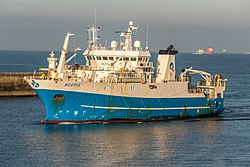Scotia (ship, 1998)
|
||||||||||||||||||||
|
||||||||||||||||||||
|
||||||||||||||||||||
|
||||||||||||||||||||
|
||||||||||||||||||||
The Scotia is a British research vessel that is primarily used for environmental monitoring and as a fisheries protection vessel in the North Sea and the Northeast Atlantic .
history
The ship was built under hull number 704 by Ferguson Shipbuilders in Port Glasgow . The ship's design came from the Norwegian company Skipsteknisk. The launching of the ship took place on 4 July 1997 and was completed in March 1998. On 21 May 1998 the ship of the British Queen Elizabeth II. Baptized .
By 2010, the ship of the Marr Group was bereedert . Marine Scotland, an agency of the Scottish Government, has been responsible for this ever since.
Technical specifications
The ship is powered by diesel-electric technology . Propulsion for the two are Ansaldo - electric motors (type: DH900DC) each with 1,500 kW power available. The power for the drive motors and the electrical system is made by three Wärtsilä - diesel engines (type: 9L20 DE) kW each with 1485 performance, the three Ansaldo- generators (type: GSCR630X8) each with 1,750 kVA apparent power drive. Furthermore, a harbor generator from the manufacturer Cummins with 240 kW output and an emergency generator from Cummins with 88 kW output were installed.
The ship is equipped with a bow thruster with 720 kW power and a stern thruster with 380 kW power. The hull of the ship is reinforced with ice ( ice class 1D).
Furnishing
On the main deck , behind the bridge structure, there is a hold that is accessible through a hatch on the boat deck. Five laboratory containers can be loaded here. The ship can be adapted relatively easily to the respective tasks. Further storage space for containers is located on the "Lower Deck" below the main deck.
The ship is equipped with various cranes, including a crane for loading and unloading the laboratory containers. The ship also has various winches and is equipped with sonar and echo sounder systems. There are two work and lifeboats on board.
On board, 17 crew members and 12 scientists can be accommodated in 27 single and one double cabins. The ship can stay at sea for 28 days.
Web links
- Ship information , Scottish Government
- Marine Scotland Topic Sheet No. 8 (PDF file, 292 kB)
Individual evidence
- ↑ a b Scotia , Skipsteknisk as. Retrieved September 22, 2017.
- ^ Scotia , Scottish Built Ships - The History of Shipbuilding in Scotland, Caledonian Maritime Research Trust. Retrieved September 22, 2017.
- ^ Vessel History , J. Marr Group. Retrieved September 22, 2017.
- ^ Scotia , Research Ship Schedules & Information, Ocean Information Center, University of Delaware . Retrieved September 22, 2017.
- ↑ a b c UK Marine Research Vessels, An assessment and proposals for improved co-ordination , Marine Science Co-ordination Committee, MSCC UK Marine Research Vessel Review April 2013 (PDF file, 903 kB). Retrieved September 22, 2017.
- ^ FRV Scotia , Scientific references, Kongsberg Maritime AS . Retrieved December 14, 2017.
